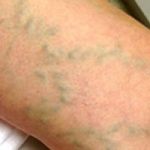All about body care > Varicose veins
Spider veins, small and large distended veins
For many people, varicose veins and spider veins — a common, mild variation of varicose veins — are simply a cosmetic concern. For other people, varicose veins can cause aching pain and discomfort. Sometimes varicose veins lead to more-serious problems. signal a higher risk of circulatory problems.
Varicose and spider veins are not only unsightly, they continue to deteriorate when left untreated and may lead to complications. Consulting a phlebologist is the best remedy!
Why do varicose veins and spider veins usually appear in the legs?
A:
Most varicose and spider veins appear in the legs due to the pressure of body weight, force of gravity, and task of carrying blood from the bottom of the body up to the heart. Compared with other veins in the body, leg veins have the toughest job of carrying blood back to the heart. They endure the most pressure. This pressure can be stronger than the one-way valves in the veins.
What are the signs of varicose veins?
A:
Varicose veins can often be seen on the skin. Some other common symptoms of varicose veins in the legs include:
• Aching pain that may get worse after sitting or standing for a long time
• Throbbing or cramping
• Heaviness
• Swelling
• Rash that’itchy or irritated
• Darkening of the skin (in severe cases)
• Restless
Thanks to Epiderma for their kind assistance 15 years of expertise and 20 cliniques at your service.
How common are abnormal leg veins?
About 50 to 55 percent of women and 40 to 45 percent of men in the United States suffer from some type of vein problem. Varicose veins affect half of people 50 years and older

Varicose and spider veins are treated with sclerotherapy or echosclerotherapy, as the case may be. At the first treatment session, the doctor performs a health check and a full examination of the varicose veins to be treated. In the case of large distended veins, he/she performs an ultrasound to view the deep veins and locate the backflow areas. He/she then determines a treatment plan and makes the first injection.
A natural irritant is injected into the vein. The vein becomes blocked in response to this irritant, then shrinks and gradually fades. The strength and quantity of the injected sclerosing agent are determined based on the size of the vein to be treated.
Treatment lasts 20 minutes and requires no recovery time.
Nearly all veins can be treated with sclerotherapy or echosclerotherapy. The process begins immediately after injection and takes a few days up to a few weeks depending on the size of the vein.
Results become visible very quickly—even for large and sometimes raised, distended veins—and are permanent.
Wearing graduated medical compression stockings is strongly recommended as part of treatment of varicose and spider veins. These stockings come in two degrees of compression. The right level will be determined by the doctor during treatment, based on your needs. They provide effective medical management of vein problems, help improve the effectiveness of treatment, and prevent new varicose veins from appearing.
These specialized stockings are available exclusively in clinics, not in pharmacies. They provide guaranteed compression and are adapted to the size of your legs.



| Spas | Care & Make-up | Health | For Men | Glossaries | Various | |||||
| Intro | Face (care) Make-up Body Hair Endless Youth Mother & Baby Corner Suncare Essentials And more... New products Spot A HairdresserMake-up Artist Directory | Healthy Diet Watching your figure Relaxation | Intro New products | All about... | Phytotherapy All Natural Fashion Perfume Jewelry & accessories And more... What is your style? |
-

 Spas
Spas
-

 Care & Make-up
Care & Make-up
-

 Health
Health
-

 For Men
For Men
-

 Glossaries
Glossaries
-

 Various
Various








